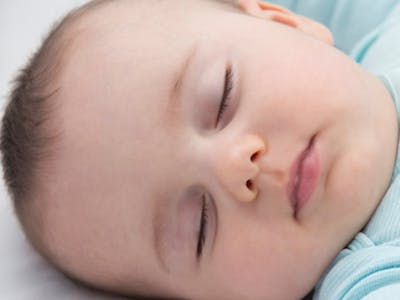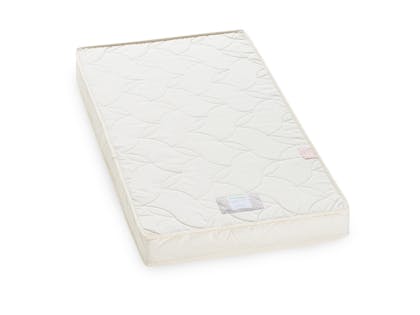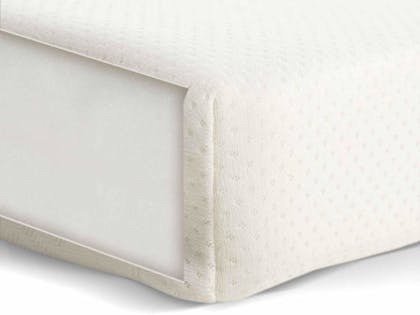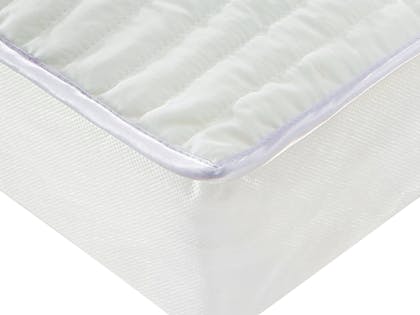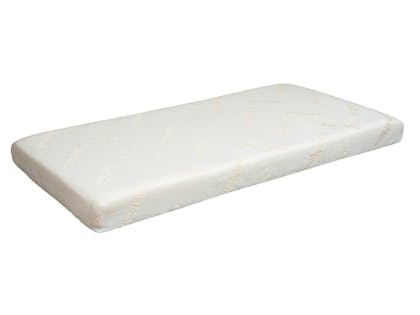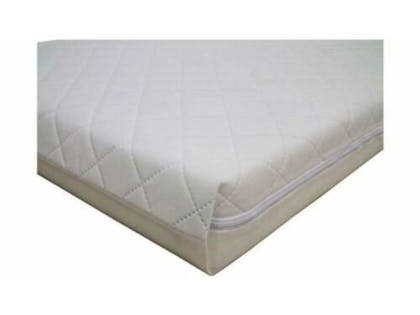best buys
The best mattresses for your baby's cot
This page contains affiliate links, which means we may earn a small amount of money if a reader clicks through and makes a purchase. All our articles and reviews are written independently by the Netmums editorial team.
Choosing a mattress for your baby's bed is more important than you might think.
Even if you buy a second-hand cot you MUST buy a new mattress, as used mattresses have been linked to an increased risk of SIDS (sudden infant death syndrome).
Whether you plan to spend a little or a lot, making sure the mattress fits correctly is essential, so double check with the retailer before you buy.
There are several different mattress types to choose from, ranging from inexpensive foam models, through to those with springs or natural and organic fillings.
Try and buy the best mattress you can afford - after all, you want your baby to have the best night's sleep possible!
How much does a cot mattress cost?
There are four types of mattress for your baby’s bed.
The cheapest is foam, followed by sprung or coiled, then pocket sprung, and finally – and most expensive – natural fibre.
Moses basket and crib mattresses range from around £8 to £30, while mattresses for cots and cot beds cover a scale from £20 to £450 or more.
What are the different types?
Of the four types of baby mattress,
foam mattresses
are the most economical buy.
They’re usually made of a single layer of foam, which should be 8-10cm thick for comfort, with a waterproof fabric cover that can often be unzipped and machine-washed so it’s easy to keep clean.
Some have ventilation holes at one end, although this isn’t necessary.
They’re a good-value option, but can make babies feel rather clammy and sweaty in bed; your baby’s weight may also lead to a permanent indentation developing in the spot where he sleeps.
Sprung or coiled mattresses are made up of coiled springs arranged vertically next to each other inside the mattress.
The springs are topped with foam or felt, and all encased in a fabric mattress cover, which usually has one waterproof, wipe-clean side.
Spring mattresses are a little more expensive than foam mattresses, but are firmer and tend not to mould to your baby’s shape.
However, the springs can sometimes be felt through the surface of the mattress, which could compromise your baby’s comfort.
Pocket sprung mattresses are also filled with springs, but they’re enclosed in individual fabric compartments.
They’re comfortable, supportive and hold their shape well, but they are among the most expensive mattresses on the market.
Finally, natural-fibre mattresses are filled with fibres such as coir (coconut fibres), coated in latex rubber for extra durability.
These mattresses don’t get deformed by your baby’s weight so they generally last a long time, which could make them a wise investment if you’re buying a cot bed that converts to a junior bed that your baby can use for several years.
The natural fibres also let air circulate so your baby doesn’t get so hot and sweaty.
However, they are expensive and aren’t as widely available as other types of mattress.
Some baby mattresses have a hypoallergenic covering that can be unzipped and machine-washed.
This helps to prevent allergic reactions caused by dust mites, pet hair and other allergens.
You can also get dual mattresses, which are designed with a different material each side for your child to sleep on, depending on their age.
Baby mattresses come in different sizes to fit moses baskets, cribs, cots and cot beds, but it’s important that you carefully check the dimensions before you buy.
Not all baby beds are regular sizes – for example, cots come in standard and continental sizes – and it’s essential that you buy a mattress that fits the bed snugly to prevent your baby getting an arm or leg trapped between the mattress and the side of the bed.
You can get mattresses made to measure if your cot is an unusual size, but this can work out as quite an expensive option.
Need to know
It’s also advised that you always buy a new mattress with a waterproof cover for your baby’s bed, even if you’re using a second-hand Moses basket, crib or cot, as this will help to protect against SIDS.
1. Little Green Sheep Natural Twist Cot Bed Mattress
* Double-sided mattress suitable for newborns to toddlers
*Made from 100% natural materials
*Free from toxins and harmful chemicals
This double-sided mattress will give your child the correct support as they grow. One side is firm, as recommended for babies up to 12 months, the other softer and more comfortable for toddlers.
It's made from breathable cotton, supportive coconut coir, comfy natural latex and hypo-allergenic wool and is both anti-dust mite and breathable, too.
Use with the Little Green Sheep waterproof mattress protector for best results.
2. Mamas & Papas Safenights Comfort Air, £224
* Eco-friendly cot bed mattress
* Hypoallergenic and water-resistant
* 140 x 70 x 10 cm to fit a standard-sized cot bed
This natural cot mattress has been designed to give your baby a great night's sleep, with a super-comfortable texture, enclosed in an organic cotton cover.
It's foam and chemical treatment-free with an eco comfort fibre core making it safer for babies and also the environment.
The mattress can be wipe-cleaned and flipped and rotated for more even wear and tear.
3. East Coast Nursery Spring Deluxe Mattress
* Hypoallergenic quilted cover
* Waterproof membrane protects the core from liquids
* Measures standard cot bed size 140 x 10 x 70 cm
This well-priced mattress has an adjustable waterproof membrane that can be positioned to protect the mattress during use from any leaks.
The high-tensile pocketed springs move independently of each other and are covered in a dent-resistant foam for added support. The cover is removable and machine-washable, too.
5. ClevaFoam Support Mattress
* Luxuriously soft foam mattress for cots
* Can help to prevent 'flat head syndrome'
*Breathable and hypoallergenic mattress that increases air flow around the cot
This breathable and hypoallergenic mattress is made using Clevafoam, which is scientifically proven to help prevent flathead syndrome.
The soft and lightweight foam reduces the pressure on the back of your baby's head by 50% and increases support by 80%, so there's less chance of your baby's head flattening at the back.
It's also hypoallergenic, ph balanced and toxin-free, so suitable for use by babies who suffer from asthma and other allergies.
6. AirComfort™ Eco Breathable Cot Bed Mattress
* Fully breathable cot bed mattress
* Reversible mattress so you can use both sides
* Measures 140 x 70cm standard cot bed size
A well-priced double-sided mattress with a waterproof lining to guard against any accidents and leaks.
It comes with a very soft and thick quilted mattress cover included that's hypoallergenic so will be extremely comfortable for little ones.
The mattress can be used both sides, so simply flip it regularly for even wear and tear.
How to buy the perfect mattress for your baby's bed
1. Buy the right size mattress
If the mattress is the wrong size, your child could become trapped in the gap between the mattress and the cot.
As a rule, this gap should be no more than 4cm (1.5 in).
If your cot, crib or Moses basket is not a standard size, and you are struggling to find a suitable mattress, there are companies that can make them specially to order so you’ll be guaranteed a safe fit.
The mattress must be at least 10cm thick, as anything thinner won't give the firm support your baby needs.
Thin foam in particular can lose its shape and dent easily.
A travel cot mattress should be at least 10cm thick, and a mattress for a crib or Moses basket should be no thinner than 5cm.
2. Make sure the mattress is firm enough
Even though it might not seem as comfortable, you need to choose a firm mattress for your newborn.
But it needs to be this firm for safety reasons.
If the mattresses's surface is too soft, it can sag or mould to a baby's shape and create a suffocation or SIDS hazard.
Even though the majority of children who die from SIDS are under one year old, it can affect toddlers too, so it's best to take care and not take any risks for the first few years of your child's life.
3. Check that your baby's mattress meets safety regulations
All mattresses should conform to the British Safety Standards and be clearly marked somewhere with this number – BS 1877-10:1997.
If you can’t find this number, you can’t be sure of the mattress’s safety and if it's the correct standard, so it’s best to avoid buying it.
4. Keep your baby's mattress clean
Your baby’s mattress needs to be kept as clean as possible to safeguard your baby's health and to avoid the build-up of bacteria.
You can either buy one with a wipe-clean covering or a removable top panel that you can wash at high temperatures.
Alternatively, you could use a mattress protector, which covers the mattress to stop it getting wet if the baby dribbles or their nappy leaks.
This mattress protector can then be removed and washed when needed.
5. A mattress must be well ventilated
Foam mattresses in particular should be made with ventilation holes to keep the air flowing and help odours to disperse.
This will help your baby to keep cool and dry, too.
Having ventilation holes also makes it easier for any fluid to drain away if your baby is sick, or if they dribble frequently during the night.
6. It’s best to buy a new mattress for your baby
Buying a new mattress is the best option, even if the cot you’re using is secondhand, but if you’re confident about where it came from, and that it’s been stored correctly (so it’s not damp) and you’ve carefully checked that it's clean, dry and free from cracks or tears, you can still use it.
Check that the mattress has a removable, washable cover too.
7. Buy the most expensive mattress for your baby that you can afford
There are four types of mattresses that you can buy for babies’ beds – foam, sprung, pocket sprung (similar to an adult mattress) or those made with natural or organic fibres like coconut coir.
Foam mattresses are the cheapest and mattresses made with organic or natural fibres are the priciest.
As they are made from more solid components, however, mattresses made with organic or natural fibres tend to be more long lasting and durable.
Take time to make sure that your chosen mattress meets safety standards, and check to see if it fits in your child's cot or crib correctly.
Sleep safety advice you need to know
1. Put baby to sleep on their back
When experts recommended that babies be placed to sleep on their back in the early 1990s, the rate of death from SIDS dropped dramatically. Statistics are now over 50% lower.
This is because babies who sleep on their front are more likely to overheat, have pauses in breathing, and rebreathe air they have just inhaled, which is low in oxygen.
Placing your baby to sleep on their back until they are at least 12 months is sound advice for protecting your baby – and you should make sure that relatives and babysitters know the rules, too.
Once they start rolling at five or six months old, you will find them in all sorts of different positions.
There is no need to panic, as their risk of SIDS has started to drop by this age, but it is worth moving them to their back when you find them in a different position.
It's also best to place your baby in the "feet to foot" position, with their feet at the end of their cot or Moses basket, according to the NHS .
2. Choose safe bedding
There have been several studies that link a higher risk of SIDS to soft sleeping surfaces, such as beanbags, sofas, comforters, waterbeds, and quilts. The NHS advises not to use duvets, quilts, baby nests, wedges, bedding rolls or pillows when your baby sleeps.
You should use a mattress that is firm, flat, well-fitting, clean and waterproof on the outside. Cover the mattress with nothing but a single well-fitted sheet.
Avoid using blankets and instead choose a sleeping bag that will keep your baby warm without any risk of their head becoming covered.
The "feet to foot" position will also help to prevent them from wriggling under the covers and their head becoming covered.
Never place soft toys inside the cot and avoid cot bumpers, which pose a risk to your baby and prevent air circulating freely.
Learn more about choosing baby bedding .
3. Avoid sleep positioners
You will find various sleep positioners on sale that promise to keep your baby on their back throughout the night.
The official advice is not to use them, after a spate of infant deaths through suffocation. Instead, make a habit of checking your baby regularly.
4. Let baby sleep in their own bed
According to the NHS , there is an association between co-sleeping with your baby on a bed, sofa or chair, and SIDS.
It can be tempting to cuddle little on the sofa all evening, but being a parent is tiring and you run the risk of dozing off too.
If that happens, your baby is at a much higher than average risk of SIDS, so you should always take your sleeping baby and place them in their basket, crib or cot to sleep on their own when they drop off.
It's especially important not to share a bed with your baby if you or your partner are smokers, have recently drunk alcohol or have taken medication or drugs that make you sleep more heavily.
Learn more about safe co-sleeping .
5. Never let them sleep for too long in their car seat
Babies can get very hot sleeping in their car seats , which means they are at a much greater risk of SIDS.
Their heads are also positioned in a way that can inhibit breathing, so you should always transfer them to their cot, crib, or Moses basket as soon as you get home.
The same rule applies for prams, bouncy seats, infant carriers, slings and swings, especially if your baby is under four months old.
In the car, you should ideally have a second adult travelling in the back with your baby, or you can use a mirror to keep an eye on them. If your baby changes position or slumps forward then it's advised to take them out and sit them upright.
6. Sleep in the same room as your baby
Statistics prove that sleeping in the same room as your baby for at least the first six months reduces the risk of SIDS significantly.
However, avoid sharing a bed with your baby as it poses risks.
Instead, place their crib, cot, or Moses basket next to your bed so they are close when they wake, and place them back inside after their feed.
7. Make sure they don't overheat
It's important that your baby doesn’t overheat when they are sleeping.
Dress them in one more layer than you would wear in the same temperature – and make sure you check on your baby regularly for signs that they are hot, such as sweating or damp hair.
Invest in a thermometer for the baby’s room so you can make sure their room is close to the NHS recommended temperature of about 18C.
Never cover their head when they are sleeping with hoods or hats, as this can increase their body temperature dramatically, and may also pose a suffocation risk.
8. Stop smoking
The NHS also advises that parents can reduce the risk of SIDS by not smoking during pregnancy or after the baby is born.
Don't let anyone smoke in the house, ask visitors to smoke outside, and avoid taking your baby into smoky places.
You can find more info on SIDS by visiting the charity Lullaby Trust , which raises awareness of sudden infant death syndrome (SIDS), provides expert advice on safer sleep for babies and offers emotional support for bereaved families.
Why do you need a new mattress for your baby?
The Lullaby Trust recommends that you buy a new mattress for each baby, as it's important that it is both clean and dry to help prevent SIDS (sudden infant death syndrome).
If you cannot afford to replace a mattress, use the one you have as long as it has a completely waterproof cover and has no tears, cracks or holes.
The Lullaby Trust also says to check that the mattress is in good condition and is firm, not soft; fits the cot without any gaps and doesn’t sag.
If you need more information about SIDS, or how your baby's health can be affected by a poorly-fitting mattress and other risks, visit the Lullaby Trust website here.
Are mattress protectors safe for babies?
Using a mattress protector can help to keep the mattress clean and stop it getting wet if your baby dribbles or their nappy leaks during the night.
It will help to keep your baby's bed as clean and hygienic as possible.
Always use a mattress protector that has been made especially for a cot or crib.
What is the safest mattress for a baby?
A mattress for a baby or toddler has to reach certain safety standards to allow for safe sleeping.
Look for a mattress that is firm and flat to support your baby comfortably and safely.
It needs to fit the cot, crib or Moses basket snugly, with no dangerous gaps around the edge.
A mattress that is well ventilated can also help a child to have a safer night's sleep.
Where can you buy mattresses for babies and toddlers?
Most nursery retailers will sell mattresses to fit cots, cribs, cot beds and toddler beds. Try Amazon , John Lewis , Kiddies Kingdom and Uber Kids.
Read on:
• Seven baby mattress rules you shouldn't ignore
• The best room thermometers for your baby
• What should your newborn wear in bed
